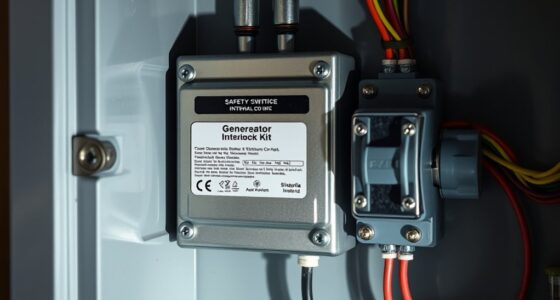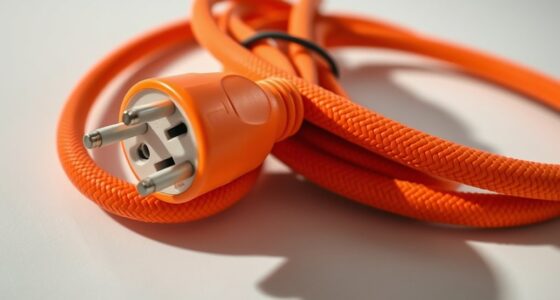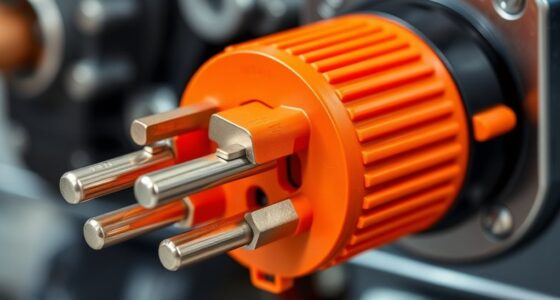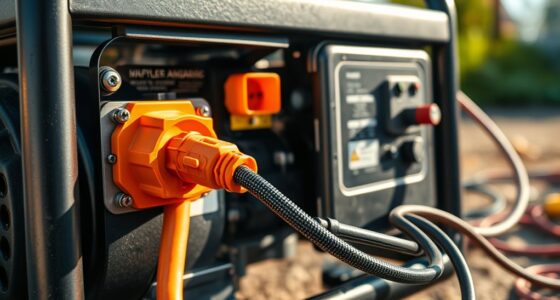To wire a 120/240 V generator cord for split-phase power, you need a proper four-prong cord with hot, neutral, and ground wires. Connect the hot wires to the appropriate terminals for 120 and 240 volts, attach the neutral wire to the neutral terminal, and securely connect the ground wire to the grounding terminal. Make certain all connections are tight and insulated. For detailed steps and safety tips, keep going to get a clearer understanding.
Key Takeaways
- Use a four-prong cord with two hot wires, a neutral, and a ground for split-phase 120/240 V power.
- Connect hot wires to their respective terminals, ensuring correct placement for 120 V and 240 V loads.
- Attach the neutral wire to the load’s neutral terminal, separate from the ground for safety.
- Securely connect the ground wire to the generator’s grounding terminal and load grounding system.
- Verify all connections are tight, insulated, and weather-rated if used outdoors, following safety standards.

When selecting generator cords for your 120/240 V power needs, it’s essential to understand the different types and their specifications. The right cord guarantees safe and efficient operation, especially when dealing with split-phase power. One of the most important considerations is grounding safety. Proper grounding prevents electrical shocks and equipment damage, so always verify that your cord is designed with a grounding conductor—typically a green or bare copper wire. This grounding safety feature connects your generator to earth ground, reducing the risk of hazardous voltage buildup. Additionally, you need to pay attention to cord compatibility. Not all cords fit every generator or load device, so check that the cord’s plug type and gauge match the receptacle and power requirements. Using an incompatible cord can lead to poor connections, overheating, or even electrical failure.
When wiring your 120/240 V generator cords, you’ll generally work with a three-prong or four-prong setup. A four-prong cord includes two hot wires, a neutral, and a ground, which is common for most modern generators and appliances. This setup ensures that the neutral and ground are separate, providing additional safety during operation. You need to connect the hot wires to the corresponding lugs or terminals—these carry the 120 V and 240 V loads—while the neutral wire handles the return current for 120 V circuits. The ground wire, meanwhile, should be securely attached to the grounding terminal or lug on your generator and the load device. Properly wiring these components ensures that your system maintains grounding safety and reduces the chance of electrical faults. It’s also crucial to use the correct insulation rating for outdoor use to prevent damage from weather conditions.
Make sure you select a cord rated for the power load you plan to draw. For example, a 10-gauge cord is suitable for most portable generator applications up to 30 amps, but heavier loads require thicker gauge wiring. Check the cord’s insulation rating to guarantee it can withstand outdoor conditions if you’re working outside. When connecting the cord, tighten all connections firmly but carefully, avoiding over-tightening that could damage terminals. When in doubt, consult your generator’s manual or a licensed electrician to verify the correct wiring configuration and confirm your cord is compatible with your generator’s specifications. Remember, safety always comes first—grounding safety and cord compatibility are key to avoiding dangerous electrical mishaps and ensuring your power setup works reliably.
Frequently Asked Questions
Can I Connect a 120/240 V Generator to a Standard Household Outlet?
You shouldn’t connect a 120/240 V generator directly to a standard household outlet. Doing so can compromise generator safety and pose risks of electrical shock or damage. Always guarantee your generator cord is compatible with your power setup and follow manufacturer instructions. Using the wrong cord or improper connection can lead to dangerous situations, so it’s best to use designated transfer switches or consult an electrician for safe, reliable power transfer.
What Safety Precautions Should I Take When Wiring Generator Cords?
When wiring generator cords, always prioritize safety. You should follow proper grounding procedures to prevent electrical shocks and equipment damage. Wear personal protective equipment like gloves and safety glasses to protect yourself from sparks or accidental contact. Before starting, turn off all power sources, verify connections, and make certain the generator is grounded correctly. Taking these precautions minimizes risks and ensures a safe, effective setup for split-phase power.
Is It Necessary to Use a Transfer Switch With My Generator?
Oh, sure, why bother with a transfer switch? Well, skipping it could turn your home into a chaotic chaos zone. A transfer switch ensures safe load management by seamlessly switching between utility power and your generator. It protects your appliances and prevents dangerous back-feeding. So, yes, it’s necessary—unless you enjoy risking damage and electrical hazards. Invest in a transfer switch for peace of mind and smart load management.
How Do I Identify the Different Wire Colors in the Cord?
You identify the different wire colors in your cord by understanding color coding and wire identification standards. Typically, black and red are hot wires, white is neutral, and green or bare copper is ground. Check the manufacturer’s label or wiring diagram for specifics, as color codes can vary. Always verify with a multimeter before handling to confirm correct connections and safe operation.
Can I Modify Existing Cords to Handle Higher Loads?
Imagine turning a bicycle into a freight truck—sounds tempting, right? You can’t just swap out a cord’s gauge and hope for the best. To handle higher loads, you need to upgrade to a thicker gauge wire and guarantee your connector compatibility. Modifying cords isn’t just risky; it’s unsafe and likely to fail. Always get a professional to rewire or buy a heavy-duty cord designed for your load.
Conclusion
By following these wiring steps, you’ll confidently connect your generator cords and keep your power flowing smoothly. Think of it as threading a needle in a tapestry—you’re weaving safety and reliability into your home’s electrical system. Remember, proper wiring isn’t just a task; it’s the lifeline that keeps your home warm, safe, and alive during power outages. With care and attention, you’ll ensure your generator’s heartbeat continues without a hitch.









